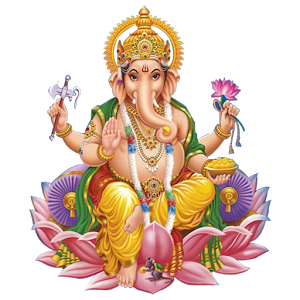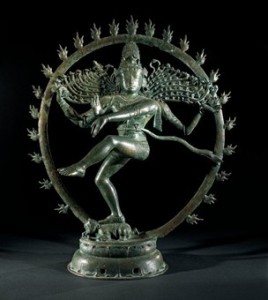Western fascinations with Hinduism’s “exotic” culture extends all the way back to the very first European colonizers, and is just, if not more prominent now that globalization is on the rise. We live in a world of constant cross-cultural exchange. Hindu religious imagery is mobilized into U.S. media and fashion and as a result taken out of their intended context; specifically Ganesh and Shiva have been prominent in their recent use reimagining in American pop culture. The significance of the original Hindu images stems from its ritualized creation and use, both with a highly complicated set of meanings and sacrality. For Hindus, “seeing” is a complex and vital act. Does placing these images out of a religious context turn the sacred into the profane? Are Americans, in a sense, appropriating cultural property?
Jas Elsner’s theories on categories of images will at first be helpful in identifying the types of images being discussed. For Elsner, there are two types of art: There is the naturalist form, which places the viewer in the position of a somewhat voyeuristic and disconnected third party, and there is the ritual centered, of which devotional imagery falls under the latter category. He says of ritual centered imagery, “In the reciprocal gaze of divine confrontation, there is a form of visuality in which the image does not just look back at the viewer, but in which the viewer has specifically made the journey in order that the image should look back “ (Elsner, 61); a concept that in Hinduism is known as darshan. The seer here is also the seen, and is to be incorporated into the divine world of the deity. Hindu imagery, for this reason, in inherently interactive.
What makes Hindu images in particular so ‘special’, is that they were made specifically as sites of divine interaction. Religious images in India are so versatile, that, “it is not only in temples and homes that one sees the images of the deities. Small icons are mounted at the front of taxis and buses. They decorate the walls of tea stalls, sweet shops, tailors, and movie theatres. They are painted on public buildings and homes by local folk artists. They are carried through the streets in great festival processions.” (Eck, 16). But what is really significant about these images is not their great abundance, but their believed containment of the deity they depict. In order that a statue is transformed to not simply a sculpture but a divine residence, “from beginning to end the fashioning of an image is governed by ritual prescriptions…For the Indian artist, the silpin, the creation of an image is, in part, a religious discipline.” (Eck, 52). In the final stage of an image’s creation, an eye-opening ceremony takes place. “Even after the breath of life (Prana) was established in the image there was the ceremony in which the eyes were ritually opened with a golden needle or with the final stroke of a paintbrush…The gaze which falls from the newly opened eyes of the deity is said to be so powerful that it must first fall upon some pleasing offering” (Eck, 7). All of this care is taken for a specific and sacred purpose; to make contact with the deity and receive a blessing. Known as darshan, the concept of reciprocal vision between the image and worshipper, transforms the seer into the seen and vice versa. The contact can be seemingly trivial, like stopping at a roadside shrine on a persons way to work (which Eck does not discuss extensively in her book, Darsan). Beholding the image is an act of worship, and through the eyes one gains the blessings of the divine.” (Eck, 3).
One such example of cultural appropriation that created a large outcry within the Hindu community was the use of Ganesh on a pair of socks, so much so that it caught the attention of Rajan Zed—He has long fought the misuse of Hindu devotional imagery in pop culture and mass media for some time now, and said about the Urban Outfitters socks, “Lord Ganesh was highly revered in Hinduism and was meant to be worshipped in temples or home shrines and not to be wrapped around one’s foot” (Huffington Post). Religious imagery in this instance has been commodified, and completely divorced from its reality.
Adding another layer of appropriation to this example, of all the taboo places to place a deity, the feet are among the worst. Ramdas Lamb, who studied the Ramnami sect of Hindu society in depth, says, “Traditional Hindu purity/pollution restrictions prohibit the inscribing of the name of a divinity or other sacred mark below the waist, whether on the body or clothing, because pf its possible contact with bodily secretions or other polluting substances. To wear a sacred symbol on the feet or shoes amounts to blasphemy in the eyes of many traditional Hindus. The Ramnamis see such regulations as contrary to the omnipotent and transformative power of the name of Ram.” (Lamb, 89). The Ramnami people are partially asserting their independence from ‘traditional’ Brahmin Hinduism and society, and partially putting forth an argument as to what they think is acceptable religiosity. “Ramnam tattoos have become, for many members of the samaj, the epitome of their individuality, freedom of expression, and willingness to visibly manifest and display their personal and collective commitment to Ram, to their beliefs and practices, and to eachother.” (Lamb, 84). Hindus with full knowledge of their own culture criticize, alter, and erode Brahmanical rules as a statement to attest to their own form of belief. This is not what Urban Outfitters is doing. Ganesh socks have divorced a religious symbol from its religious meaning and gone one step further by placing it onto a person’s feet.
The fashion industry is not the only place where we see cultural appropriation taking place-
Even highly regarded magazines such as Newsweek are guilty of such offenses. In 2010, Newsweek printed a cover depicting Obama with six arms, all balancing political responsibilities, and one leg raised, with the title “God of All Things,” in a clear attempt to bring to mind the Hindu deity Lord Shiva in his dancing Nataraja form. This November 22nd cover outraged the Hindu American Foundation (HAF). HAF has released numerous statements on this topic; they are among the “who” that western cultural sensitivity applies to. The HAF website states, ””Hinduism’s sacred images are too often appropriated in popular culture without understanding their spiritual relevance to Hindus,” said Sahug Shukla, HAF’s Managing Director and Legal Counsel. “For Hindus, the iconography gives insight into the divine realm, and each aspect of representation is replete with profound symbolism that is lost and even debased by such attempts at Humor.””
As Rachel Fell McDermott says, “Much of the New Age writing on Hindu goddesses is based on erroneous knowledge of India and Hinduism…and says more about the fertile and wounded imaginations of its western authors than it does about deity veneration in India.” (McDermott, 726). Personally, I think this applies to not just writings on the goddesses, but to depictions of Hinduism as a whole. Since the British first colonized the region in the 18th and 19th centuries (Lorenzen, 654), the orientalist view of Hindu culture has been frequently reimagined and appropriated into a number of different contexts.
David Lorenzen, “Who Invented Hinduism?” in Comparative Studies in Society and History, Vol. 41, No. 4 (Oct,1999), pp.630-659.
Ramdas Lamb, Rapt in the Name: The Ramnamis, Ramnam, and Untouchable Religion in Central India (Albany: State University of New York Press, 2002)
Diana L. Eck. Darsan, seeing the divine image in India. (Columbia University Press, 1998). Chichester, West Sussex. 3rd Edition.
Jas Elsner, “Between Mimesis and Divine Power: Visuality in the Greco-Roman World,” in Visuality Before and Beyond the Renaissance: Seeing as Others Saw, ed. Robert S. Nelson (Cambridge University Press, 200).
Rachel Fell McDermott, “New Age Hinduism, New Age Orientalism, and the Second-Generation South Asian,” Journal of the American Academy of Religion. Vol. 68, no. 4 (2004): 721–31
Shiva as Nataraja. Web. 1100. The British Museum. Trustees of the British Museum. 14 Oct 2014.
Obama God of All Things. Web. 16 Dec 2010. Coverjunkie. 5 Nov 2014.




